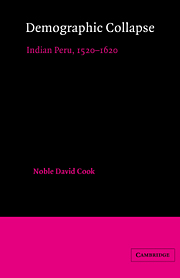Book contents
- Frontmatter
- Contents
- List of tables, figures, and maps
- Preface
- Introduction: The problem in perspective
- Part I Peru's preconquest population
- 1 The ecological approach
- 2 Population and archaeology
- 3 Depopulation ratios
- 4 Estimates from social organization
- 5 Disease mortality models
- 6 Census projections
- 7 Conclusion
- Part II Demographic collapse
- Abbreviations used in notes
- Notes
- Bibliography
- Index
- Titles in the series
- Frontmatter
- Contents
- List of tables, figures, and maps
- Preface
- Introduction: The problem in perspective
- Part I Peru's preconquest population
- 1 The ecological approach
- 2 Population and archaeology
- 3 Depopulation ratios
- 4 Estimates from social organization
- 5 Disease mortality models
- 6 Census projections
- 7 Conclusion
- Part II Demographic collapse
- Abbreviations used in notes
- Notes
- Bibliography
- Index
- Titles in the series
Summary
In the previous chapters we examined a variety of approaches to making population estimates of the native population of Peru before first direct contact with the Old World invaders or the diseases that preceded the Europeans. Some of the avenues are less useful than others, and we had to discard them outright.
The ecological model, or a study of the carrying capacity of pre-Columbian Peru, may best suggest the limits of population growth. There is certainly a maximum population that may be sustained by an ecosystem. Due to the nature of Peru's coastal agriculture, it is easier to establish theoretical maximums for coastal valleys than for the highlands. The maximum 6.5 million that we reached (Table 3) for the coastal population is, in my view, a valid high point, but the total productivity of the highlands is not well enough known to establish a limit for that area. At best, we might apply seven people per square hectare as the carrying capacity of Peru's total cultivated land in 1961 to arrive at a figure of 13.3 million. This highly tentative number is about as good as any other figure one is able currently to derive from the method, given the large number of variables and the insufficient evidence. The question of whether the Empire reached the limits of the agricultural base is not yet fully answered. Evidence that it did comes from the extension of cultivated lands into marginal areas: ridged fields in floodplains, sunken fields along the coast, extensive terracing of the hillsides. Warfare did not seem to be a significant check on growth, however, nor did famines.
- Type
- Chapter
- Information
- Demographic CollapseIndian Peru, 1520–1620, pp. 108 - 114Publisher: Cambridge University PressPrint publication year: 1982

